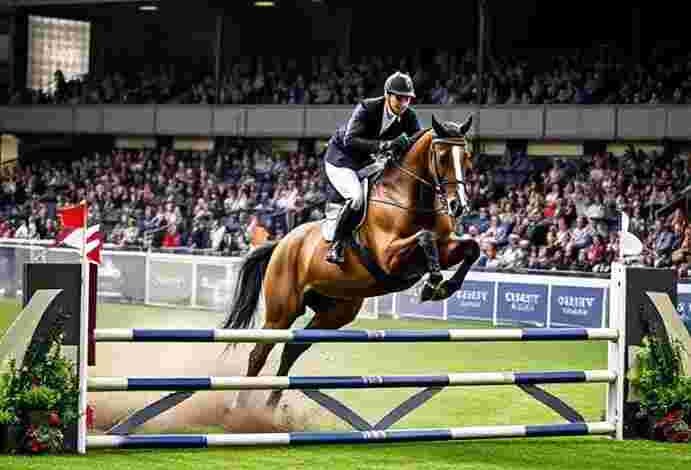British Eventing: The Heartbeat of Equestrian Sport in the UK

When you think of equestrian sports in the UK, one name stands out—British Eventing. This thrilling discipline combines the elegance of dressage, the challenge of cross-country, and the precision of show jumping into a single, adrenaline-pumping sport. Over the years, British Eventing has grown from a niche activity into a national phenomenon that captures the hearts of riders, spectators, and enthusiasts alike. Whether you’re a seasoned rider or simply curious about what makes this sport so captivating, understanding the core of British Eventing reveals a world rich with history, passion, and relentless spirit.
In this deep dive, we’ll explore the roots of British Eventing, how it operates today, and why it continues to be a cornerstone of the UK’s equestrian landscape. From its origins to the latest developments in 2025, this guide aims to give you a comprehensive view of what makes British Eventing so special—and why it’s poised to stay at the forefront of equestrian sport for years to come.
The Roots and Evolution of British Eventing
A Brief History of British Eventing
British Eventing, often affectionately referred to as BE, has a history that stretches back over a century. Its origins trace to the early 20th century, when cavalry officers and military riders sought a sport that tested their horsemanship skills in a comprehensive way. Originally, it was closely linked to military skills, with the primary goal of preparing soldiers for battlefield scenarios.
By the mid-1900s, British Eventing had evolved into a civilian sport, becoming more structured and accessible to amateurs and enthusiasts. The establishment of national rules, safety standards, and a clear competition format helped solidify its place in the UK’s sporting calendar. Over time, it grew in popularity, fueled by the nation’s deep-rooted love of horses and a competitive spirit that’s been part of British culture for centuries.
Today, British Eventing is recognized worldwide as one of the most rigorous and well-organized eventing systems. It boasts a thriving community, a rich calendar of competitions, and a reputation for excellence that attracts international riders and spectators. The sport’s evolution reflects broader changes in equestrian sport, emphasizing safety, inclusivity, and innovation.
How British Eventing Became a National Institution
The growth of British Eventing wasn’t accidental. It was driven by dedicated organizations, passionate riders, and a supportive infrastructure that nurtured talent from grassroots levels to elite competition. The British Equestrian Federation (BEF) plays a pivotal role in overseeing the sport’s development, ensuring standards are maintained, and promoting equestrian sports across the UK.
Moreover, the sport’s accessibility has expanded significantly thanks to regional clubs, training facilities, and youth initiatives. Programs like the Pony Club and British Eventing’s Young Riders scheme have cultivated a new generation of athletes, ensuring the sport remains vibrant and relevant. These efforts have also helped foster a sense of community, where shared love for horses and competitive spirit go hand-in-hand.
The integration of cutting-edge technology, safety innovations, and environmental considerations in recent years has also propelled British Eventing into a modern, forward-thinking sport. It’s a perfect blend of tradition and innovation—something that continues to attract new fans and participants while respecting its historic roots.
How Does British Eventing Work Today?
The Competition Format: From Novice to Elite
At its core, British Eventing offers a structured pathway for riders of all skill levels, from absolute beginners to Olympic contenders. Competitions are typically divided into three phases: dressage, cross-country, and show jumping. Each phase tests different skills, making eventing a comprehensive assessment of horsemanship.
- Dressage: The opening phase, where riders perform a series of predetermined movements to demonstrate the horse’s training, obedience, and harmony with the rider. Judges score based on precision, suppleness, and fluidity.
- Cross-country: The most adrenaline-fueled phase, featuring a challenging course over natural terrain with jumps, water hazards, and varied obstacles. It tests the horse’s stamina, bravery, and the rider’s strategic planning.
- Show Jumping: The final phase, where riders navigate a course of fences within a set time. It emphasizes agility, accuracy, and the horse’s responsiveness after the intense cross-country.
Each competition has a predetermined maximum score, with penalties for faults like refusals, time penalties, or errors in the dressage. The rider with the fewest penalties at the end of all three phases wins.
The Organizational Structure and Key Events
British Eventing organizes a calendar of over 200 competitions annually, ranging from local grassroots events to high-profile international fixtures. The sport’s flagship event, Badminton Horse Trials, is often regarded as the Wimbledon of eventing—an iconic, prestigious competition that attracts the world’s best riders.
Other major events include Burghley Horse Trials, Blenheim Palace International, and the Royal Windsor Horse Show. These competitions not only showcase top-tier talent but also serve as platforms for emerging riders to gain experience and recognition. The BE’s structured rankings and qualification systems ensure a steady progression for ambitious riders aiming for the Olympics or World Championships.
The organization’s commitment to safety, rider education, and environmental sustainability has helped British Eventing maintain its reputation as a world leader. Thanks to a collaborative approach involving riders, organizers, and officials, the sport continues to evolve in a responsible and inclusive manner.
The Role of Riders, Horses, and Support Teams
British Eventing isn’t just about individual talent; it’s a team effort. Riders rely on a robust support network—trainers, grooms, vets, and family members—who all play crucial roles in preparing for competitions. The relationship between rider and horse is at the heart of the sport, built on trust, communication, and mutual respect.
Training is a continuous process that emphasizes not only technical skills but also horse welfare and safety. Modern riders often incorporate physiotherapy, nutrition, and mental conditioning into their routines. The best equestrian athletes today understand that success depends on harmony, consistency, and adaptability.
Horses are treated as athletes in their own right, with dedicated care routines to optimize performance and longevity. The sport’s governing bodies strictly enforce welfare standards, ensuring that horses compete in humane, safe conditions. This holistic approach has contributed to British Eventing’s reputation as a sport that values excellence without compromising animal welfare.
The Future of British Eventing
Innovation and Sustainability in the Sport
Looking ahead, British Eventing is embracing technological advancements to enhance safety, training, and spectator engagement. Virtual reality training, wearable tech for horses, and data analytics are becoming commonplace among top riders and trainers. These innovations help identify areas for improvement and prevent injuries, pushing the sport into a new era of precision and safety.
Sustainability is also gaining importance. From eco-friendly event venues to environmentally conscious footing materials, the sport is actively working to reduce its carbon footprint. The use of renewable energy sources and waste reduction initiatives are increasingly integrated into event planning, aligning with broader societal goals of environmental stewardship.
Promoting Inclusivity and Grassroots Development
British Eventing recognizes the importance of making the sport accessible to everyone. Initiatives like inclusive riding programs and scholarships aim to break down barriers related to age, gender, and socioeconomic status. The sport’s community is actively diversifying, with more riders from varied backgrounds contributing to its vibrancy.
Grassroots development remains a priority, with programs designed to nurture talent from a young age. The success stories of riders who started in local clubs and went on to compete at international levels serve as inspiration for newcomers. This long-term investment in the sport’s future ensures that British Eventing remains dynamic, innovative, and inclusive.
Why British Eventing Will Continue to Thrive
The enduring appeal of British Eventing lies in its unique blend of tradition and innovation. It appeals to a broad audience—those seeking the thrill of competition, the beauty of equine partnership, and the camaraderie of a passionate community. As the sport continues to adapt to changing times, its core values of excellence, safety, and respect for horses will keep it relevant.
Moreover, the UK’s rich equestrian culture and world-class infrastructure position British Eventing as a leader on the global stage. With continued investment, innovation, and inclusivity, it’s clear that British Eventing will remain a vital part of the country’s sporting landscape for decades to come.
FAQs About British Eventing
Q: Is British Eventing only for professional riders?
Not at all! British Eventing caters to everyone—from complete beginners to seasoned professionals. The sport’s structure supports all levels, with local grassroots events and training programs designed to help newcomers get started safely.
Q: What makes British Eventing different from other equestrian sports?
Its multi-phase format—dressage, cross-country, and show jumping—sets it apart. The combination of elegance, endurance, and agility makes it uniquely challenging and exciting. Plus, the UK’s deep-rooted history and community spirit give it a distinctive charm.
Q: Can I watch British Eventing competitions in person?
Absolutely! Major events like Badminton and Burghley draw thousands of spectators each year. Many venues also offer live streaming and online coverage, so even if you can’t attend in person, you can enjoy the action from home.
Q: How do I get involved if I want to try eventing?
Start by joining a local riding club or Pony Club chapter. Many venues offer introductory clinics and beginner courses. As you gain confidence, you can progress to more formal competitions, always prioritizing safety and horse welfare.
Q: What’s the biggest challenge in British Eventing?
Maintaining safety standards while pushing the boundaries of the sport is an ongoing challenge. Balancing innovation with tradition, ensuring horses’ well-being, and making the sport accessible to all remain key priorities for organizers and riders alike.
Wrapping Up: Why British Eventing Continues to Capture Our Hearts
British Eventing embodies the spirit of adventure, partnership, and resilience. Its rich history, combined with a modern approach to safety, inclusivity, and innovation, ensures it remains a beloved sport in the UK and beyond. Whether you’re inspired by its history, captivated by its thrill, or eager to get involved yourself, there’s no denying that British Eventing is more than just a sport—it’s a way of life.
As the sport continues to evolve into 2025 and beyond, one thing remains constant: the unwavering passion of those who dedicate their lives to mastering the art of eventing, and the incredible horses that make it all possible. If you’re looking to explore the world of equestrian sport, British Eventing offers a vibrant, welcoming community eager to share its love for all things horse-related.
Interested in learning more or getting started? Dive into local clubs, attend a competition, or simply enjoy watching the incredible feats of skill and bravery that define British Eventing—where tradition meets innovation on the grandest of stages.



